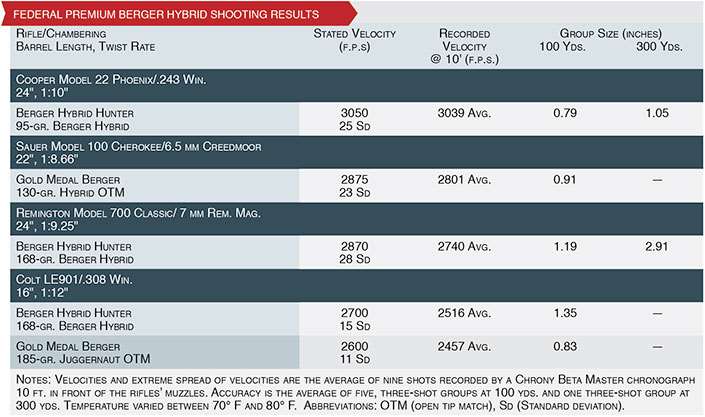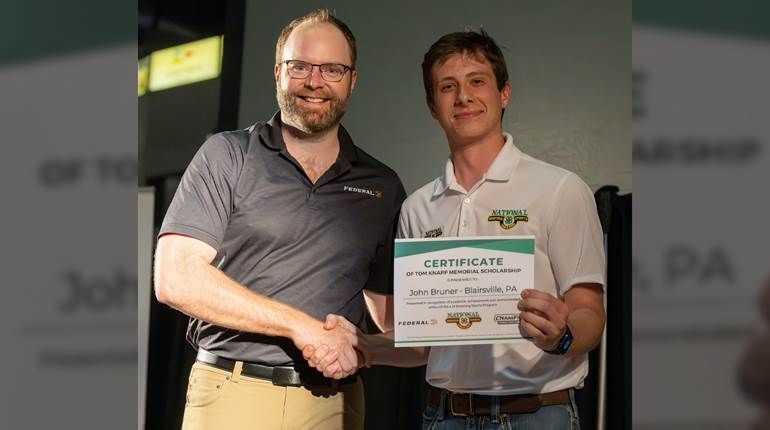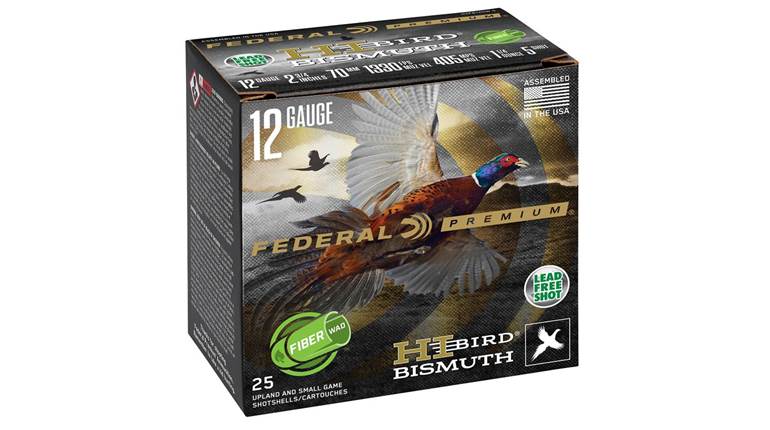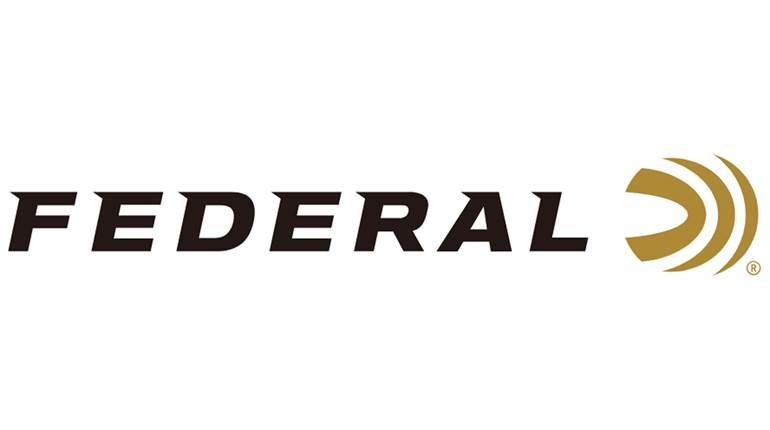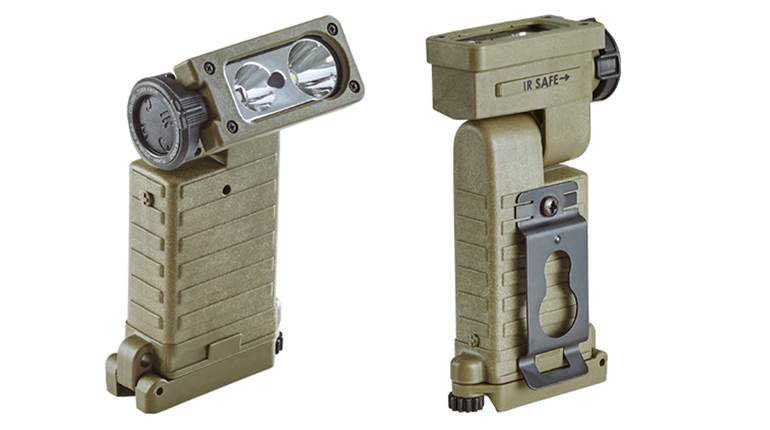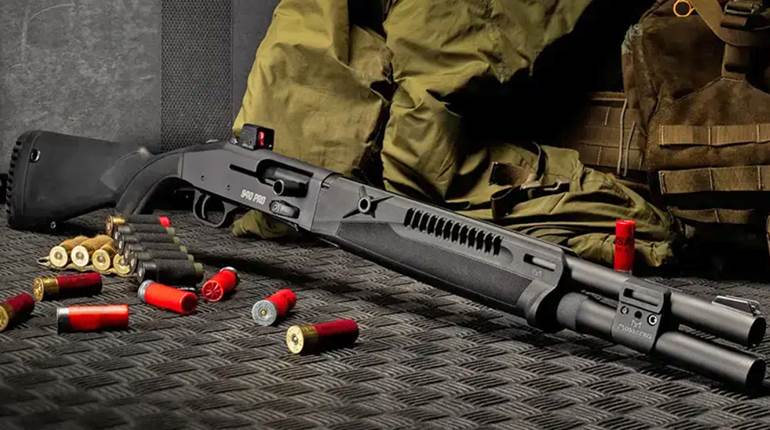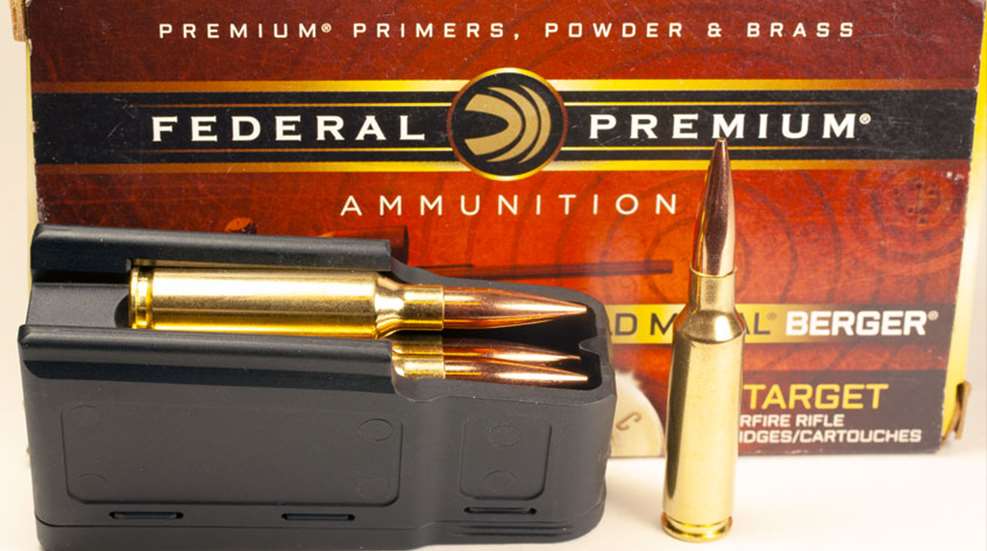
Federal has long selected the best projectiles, including those from other manufacturers, to load its cartridges, and Berger is no exception. Its Hybrid bullets shoot accurately even when seated short of a cartridge’s maximum length, allowing rounds to fit in a magazine.
Federal Ammunition’s forte has always been offering a considerable variety of bullets in the center-fire rifle cartridges that it loads. Federal, of course, employs its own bullets, such as the Copper and Trophy Copper, Fusion, Trophy Bonded Tip and Bear Claw, Edge TLR, and Terminal Ascent. But it also unhesitatingly steps across company lines to include great-performing bullets from Barnes, Nosler and Sierra in its Premium rifle cartridges.
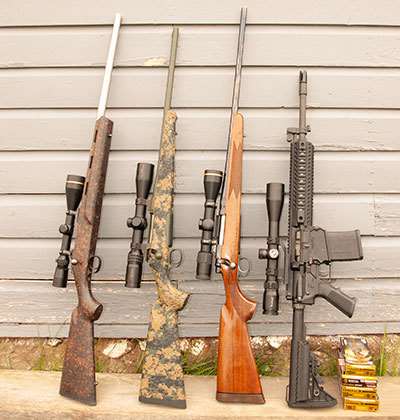
Berger Hybrid Hunter and Gold Medal Hybrid bullets are the newest projectiles to join Federal’s Premium line. Federal loads Hybrid Hunter bullets in nine cartridges, from .243 Win. to .300 WSM, and Gold Medal Hybrid open-tip match (OTM) bullets in 6 mm Creedmoor, 6.5 mm Creedmoor and 6.5 mm Grendel.
Through the years, handloaders have enjoyed great success shooting Berger’s Very Low Drag (VLD) bullets, which incorporate a boattail and a long secant ogive that produce a high ballistic coefficient to reduce drag and wind deflection. Berger is the first to admit, however, that the secant ogive of VLD bullets “can be sensitive to seating depth,” according to the Berger Bullets Reloading Manual 1st Edition.
The manual goes into great detail on how to adjust VLD bullet seating depth to set bullets certain distances from contacting rifling, and recommends shooting multiple shots to find the accuracy “sweet spot” for a particular rifle. But that optimum cartridge length may be impractical for factory cartridges that must fit within a magazine and shoot precisely through a multitude of rifles.
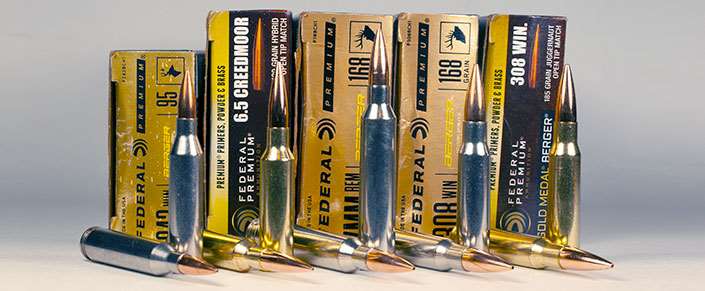
Hybrid bullets reduce that seating depth sensitivity by blending two geometric shapes to the nose of the bullets. “As the bearing surface ends, a tangent ogive begins,” according to the Berger Bullets website. The tangent section of the ogive has a somewhat rounded shoulder that helps bullets shoot more precisely without the need to position them an exact distance from the start of the rifling.
Forward on the tangent portion, the shape changes into a secant ogive. “The key to all this is not just the combining of these two shapes but also the partnership between the ballistician and the bullet maker. Chief Ballistician Bryan Litz uses his expertise to combine the appropriate shapes for optimum performance,” according to Berger.
The difference is slight between the VLD and Hybrid bullets’ ability to slice through the air and defy the wind. The G1 ballistic coefficient (BC) of Hybrid Hunting bullets is slightly lower than comparable VLD Hunting bullets.
For example, the BC is 0.434 for .243-cal. 95-gr. Hybrid Hunter bullets, while the BC is 0.467 for VLD Hunting bullets of the same caliber and weight. The BC is 0.566 for 7 mm 168-gr. Hybrid Hunter bullets and 0.617 for VLD Hunting bullets of the same weight. The higher BC translates into VLD bullets drifting less in a 10 m.p.h. wind and dropping about 2.5" less way out at 600 yds. than equivalent Hybrid Hunter bullets.
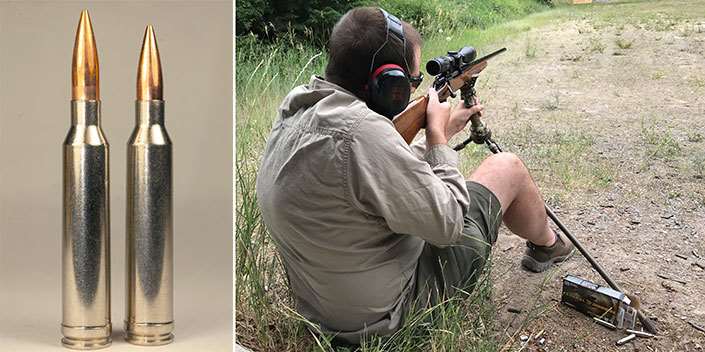
While these numbers are all well and good, how precisely Federal loads Hybrid bullets to shoot their best is the real test. I applied a digital caliper to Federal Premium .243 Win., 7 mm Rem. Mag. and .308 Win. cartridges loaded with Hybrid Hunter bullets and 6.5 mm Creedmoor cartridges loaded with Hybrid OTM bullets. Overall cartridge length of the four different cartridges measured a smidgen short of set maximums. The length of the .308 Win. cartridges measured 2.787", 0.023" below its established limit; the .243 Win. cartridges measured 2.665", 0.045" short of maximum.
Measuring 10 .243 Win. cartridges loaded with 95-gr. Hybrid Hunter bullets, cartridge overall length (COL) varied up to .003", and cartridge head base (CHB) to the start of the ogive differed 0.004". The COL fluctuated 0.005" and CHB to start of ogive 0.002" for 168-gr. Hybrid Hunter bullets loaded in the 7 mm Rem. Mag. And the COL ranged up to 0.005" on .308 Win. cartridges loaded with 168-gr. Hybrid Hunter bullets and CHB to start of the ogive differed 0.004". Uniform CHB to start of the ogive is important because the junction of the ogive first contacts the rifling and because consistency from bullet to bullet is essential to accuracy.
Bullets concentric with the case body were gauged with a Hornady Lock-N-Load Concentricity Tool. Hybrid Hunter 168-gr. bullets loaded in the .308 Win. cartridges fluctuated from straight 0.00", 0.001", 0.001", 0.002" and 0.003". Hybrid Hunter bullets in .243 Win. and 7 mm Rem. Mag. cartridges strayed from straight about the same slight amount. Hybrid OTM bullets differed from straight in 6.5 mm Creedmoor cases somewhat more at 0.005", 0.005", 0.004", 0.003" and 0.003".
All this measuring and figuring was as wearisome as listening to politicians. I perked up, though, when time arrived to shoot. The rifles fired to test Federal’s Hybrid bullets have been shot a lot over the years.
The original owner of the Cooper Firearms Model 22 Phoenix .243 Win. returned it to the Cooper company, saying it was “inaccurate.” The rifle arrived in my hands through some creative trading, and ever since has shot fine, even well enough to win a few rounds at the annual Cooper One Shot Competition.
The rifle did not disappoint shooting Federal Premium Berger Hybrid Hunter loads with a 0.79" average for five, three-shot groups at 100 yds. and three bullets within 1.50" at 300 yds. The Cooper has a relatively short chamber throat because, on firing, the bullets traveled only 0.039" before contacting the rifling. Velocity was right up there, at 3039 f.p.s., which was only 11 f.p.s. slower than the velocity printed on the cartridge box.
I’ve been doing my best to wear out the rifling of a Sauer Model 100 Cherokee 6.5 mm Creedmoor during the past few months. A borescope, though, showed barely a blemish in the Sauer’s bore from all that shooting, and Hybrid OTM bullets only had to jump 0.092" to engage the rifling lands. The Sauer 6.5 mm grouped Federal Premium 130-gr. Gold Medal Hybrid bullets from 0.63" to 1.02". The average velocity of 2801 f.p.s. from the Sauer’s 22" barrel was just short of the 2875 f.p.s. stated on the Federal box.
The Remington Model 700 Classic 7 mm Rem. Mag. has earned its wear during the past 30 years of hunting elk. The rifle tends to spread bullets somewhat as its barrel heats up. Still, 168-gr. Hybrid Hunter bullets averaged 1.19" groups at 100 yds. and one at 300 yds. that measured 2.91".
That is more than fine accuracy from a worn-barrel bore. In fact, the Hybrid Hunter bullets made a jump of 0.149" before reaching the rifling lands. From the Classic’s 24" barrel, Hybrid Hunter bullets shot 130 f.p.s. slow of the 2870 f.p.s. Federal declares. Bullets hitting on aim at 100 yds. dropped 11" below aim at 300 yds.
The Colt LE901 .308 Win. is an accurate rifle with a trigger similar to pulling the handle on a car jack. The autoloader’s 10-lb., 14-oz. weight (with scope) sits heavily on a rest, and timing movement from pulling the trigger with the scope’s reticle on a target resulted in some tight groups. Gold Medal Berger 185-gr. Juggernaut OTM bullets grouped from a tight 0.47" to 1.02" at 100 yds. Velocity was a bit slow, at 2457 f.p.s., from the Colt’s 16" barrel. However, a .308 with a 20" barrel shot Juggernaut bullets at 2532 f.p.s., not all that much slower than the 2600 f.p.s. Federal lists. The Colt shot Hybrid Hunter 168-gr. bullets close behind in accuracy, with groups averaging 1.35".
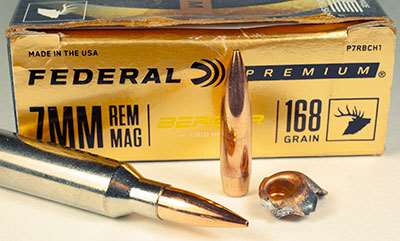
Hybrid Hunting Bullet
Berger states that its hunting bullets incorporate a sharp nose and thin jacket that enable them to penetrate 2" to 3" before they start to expand. After bullets start to expand, they shed 40 to 85 percent of their weight, sending the fragments into surrounding tissue.
“The combination between the shrapnel and the hydrostatic shock produces a massive wound cavity within the vital area (internal organs) that will be 13" to 15" long,” Berger states. Many hunters consider hydrostatic shock to be a theory at best, believing that no such thing exists as a damaging pressure wave that radiates outward from a penetrating bullet, especially with game the size of elk and moose. The only agreement on both sides of the debate is to continue disagreeing.
With no game season open during the heat of summer, I shot bundles of water-soaked paper to test Hybrid Hunter bullets. The 168-gr. Hybrid Hunter bullets fired from my 7 mm Rem. Mag. hit the paper bundles placed at 100 yds. with a velocity of approximately 2580 f.p.s. Judging by the holes punched in the paper, the bullets penciled in 5" before they started to rapidly expand.
From there to 10" deep, the bullets created about a 3" diameter cavity in the paper, with pieces of jacket and lead core peppering the path. Holes significantly narrowed after that depth, and penetration stopped 15" into the paper. All that remained of the bullets was the torn base of the jacket that weighed about 35 grs.
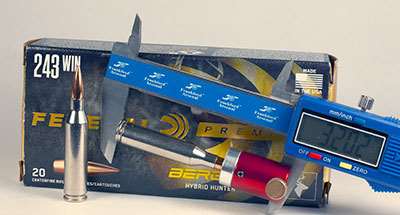
Fired from the Cooper .243 Win., 95-gr. Hybrid Hunter bullets struck the paper bundles at a speed of about 2820 f.p.s. at 100 yds. The holes in the paper showed that the bullets started expanding about 2" in and ripped large holes from there to 6" deep. The bullets were recovered 8" into the bundles, leaving only the base of the jackets that weighed about 20 grs.
Expansion and fragmentation of the 7 mm and .243 Hybrid Hunter bullets pretty much mirrored how Berger defined their performance, and the bullets should work well on broadside shots at big game.
The addition of Berger Hybrid Hunter and Gold Medal Hybrid bullets to Federal’s extensive Premium center-fire rifle line adds yet more choice for shooters and hunters. The bullets’ hybrid ogive was not fussy about sitting an exact distance from rifling to achieve good accuracy, clearly demonstrated by my well-worn Remington Model 700 7 mm Rem. Mag.
The accuracy of Hybrid bullets fired in the Cooper Model 22 .243 Win. and Colt LE901 .308 Win. was more than acceptable considering the variety of rifles. Penetrating deeply and creating a large wound channel in big game, Hybrid Hunter bullets add even more versatility to Federal’s already expansive line of Premium load offerings.
